Let’s dive into what estimation means in the world of software development and why it matters. In simple terms, it’s like predicting how much time and effort, measured in hours, days, or weeks, it will take to build a piece of software. Think of it as an educated guess, considering things like past experience, how tricky the technical stuff is, what the software needs, and the resources available. It’s not a crystal-clear prediction, but more of a well-informed estimate based on different factors.
Top 5 Techniques of Effective Software Development Project Estimation
Embarking on a software development journey requires not only technical prowess but also a keen understanding of project estimation. It’s a delicate dance between foreseeing the unknown and managing expectations. In this article, let’s explore some fascinating software development project estimation techniques that can turn the estimation process into an insightful roadmap for success.
- Analogous Estimation
Imagine you’re about to start a new project, and you’re wondering how long it might take. Analogous estimation steps in like a wise elder, drawing parallels with similar past projects. If a previous endeavor took six months to complete, chances are your current venture might follow a similar trajectory. It’s a pragmatic approach that leans on historical wisdom.
Example: If a team recently developed a mobile app with features resembling your upcoming project, analogous estimation could provide a ballpark figure based on that prior experience.
- Bottom-up Estimates
Think of bottom-up estimation as constructing a building, one brick at a time. Break down your project into its fundamental tasks, estimate each one individually, and then assemble the pieces. It’s like creating a project mosaic, where the beauty lies in the details.
Example: For a web development project, breaking down tasks might involve estimating time for front-end design, back-end development, database integration, and testing.
- Project Evaluation and Review Technique (PERT)
Sometimes, uncertainty is the only certain thing. PERT recognizes this reality by incorporating optimistic, pessimistic, and most likely estimates. If you’re unsure about certain aspects of your project, PERT provides a safety net, helping you navigate the unpredictable.
Example: When developing a cutting-edge feature with unknown challenges, PERT allows you to consider best-case, worst-case, and most likely scenarios for a more balanced estimate.
- Putting Functionality into Numbers
In a world driven by user experience, Use Case Points estimation focuses on the functional aspects of a project. Imagine assigning points to each use case based on its complexity. This method quantifies the user-centric nature of your project.
Example:Let’s consider the development of an e-commerce platform. Assigning Use Case Points involves quantifying the complexity of functionalities such as user registration or product search. For instance, a straightforward user registration process might be assigned fewer points, while a more intricate product search feature could receive a higher point value. This method provides a tangible way to measure the user-driven components of a project, offering valuable insights for accurate estimation and resource planning.
- What-If Analysis
What if your project encounters unexpected hurdles? What if a certain technology isn’t as efficient as anticipated? What-If Analysis encourages you to play out these scenarios, preparing you for potential curveballs. By playing out various scenarios, teams can proactively prepare for unexpected challenges, ensuring they have the resilience and adaptability to navigate curveballs that may arise during the project lifecycle.
Example: Imagine undertaking a web application project. What-If Analysis prompts consideration of a sudden surge in user traffic, a common occurrence for successful applications. By envisioning and preparing for this scenario, the development team can strategize and implement scalable infrastructure solutions, ensuring the application remains robust and responsive even under unexpected loads.
- Expert Judgment
In the realm of uncertainty, the expertise of seasoned professionals can be a beacon. Expert judgment involves seeking insights from those who’ve navigated similar waters. It’s like having a compass in uncharted territory.
Example: When confronted with uncertainties about the feasibility and time requirements of a specific feature, turning to Expert Judgment involves consulting a senior developer or project manager. Their seasoned insights can offer a clearer understanding of the challenges, potential solutions, and a realistic timeline for implementation. This collaborative approach ensures that decisions are informed by the collective wisdom of those who have successfully tackled similar complexities in the past.
Estimating Pitfalls
Navigating the terrain of software development project estimation isn’t without its challenges. Here are some common pitfalls to watch out for:
- Over-Optimism: The Rose-Colored Glasses Syndrome
Envisioning a seamless integration of a complex algorithm without acknowledging potential debugging challenges can lead to overly optimistic estimates. It’s crucial to maintain a realistic outlook on the intricacies involved.
- Scope Creep: When the Goalposts Keep Moving
Adding new features to a project midway without reassessing the timeline and resources required can result in an expanding scope. This phenomenon, known as scope creep, often leads to delays and budget overruns.
- Lack of Historical Data: Flying Blind in Uncharted Waters
Initiating a project in a domain where the team lacks prior experience leaves them in uncharted waters. The absence of historical data makes accurate estimation challenging and increases the risk of overlooking crucial factors.
- Ignoring Risks: Pretending the Storm Won’t Come
Failing to account for potential risks and external factors, such as third-party service outages, can lead to underestimation. Acknowledging and planning for potential challenges is integral to creating resilient estimates.
- Inadequate Communication: The Broken Telephone Problem
Communication breakdowns among team members regarding the scope of work can result in discrepancies in estimates. Clear and consistent communication is vital to align everyone on project expectations and requirements.
How JetSoftPro estimates its projects
Estimating projects at JetSoftPro is more than just a routine step in project management; it’s a thoughtful and dynamic approach driven by our commitment to excellence. We want to make sure we not only meet but exceed expectations.
Before we embark on the estimation journey, we take the time to get to know each project. We sit down with our clients, chat about their needs, dive into project goals, and define the scope of work. The goal is to build a shared understanding of what the project is all about, what challenges we might face, and what everyone hopes to achieve.
Our team of Engagement Managers, the real heroes behind the scenes, bring a ton of expertise to the table. Whether it’s figuring out Agile estimates for those fast-paced projects or diving into parametric estimation for accuracy backed by data, our team adapts to the unique needs of each project.
We don’t stick to a one-size-fits-all method. Instead, we mix it up with approaches like analogous estimation, expert judgment, and digging into historical data. This flexibility ensures that our estimates are not only spot-on but also perfectly suited to the size, complexity, and specific industry quirks of each project.
We’re all about options. JetSoftPro offers a smorgasbord of technology stacks and tools, giving projects the freedom to pick what works best for them. Whether it’s web development, mobile apps, cloud solutions, or enterprise software, we’ve got the expertise to handle it all.
In a nutshell, at JetSoftPro, estimating projects is about understanding, adapting, and always striving for improvement. We’re not just estimating; we’re crafting a roadmap that leads to project success. Get in touch with us today if you require assistance with your product development.

